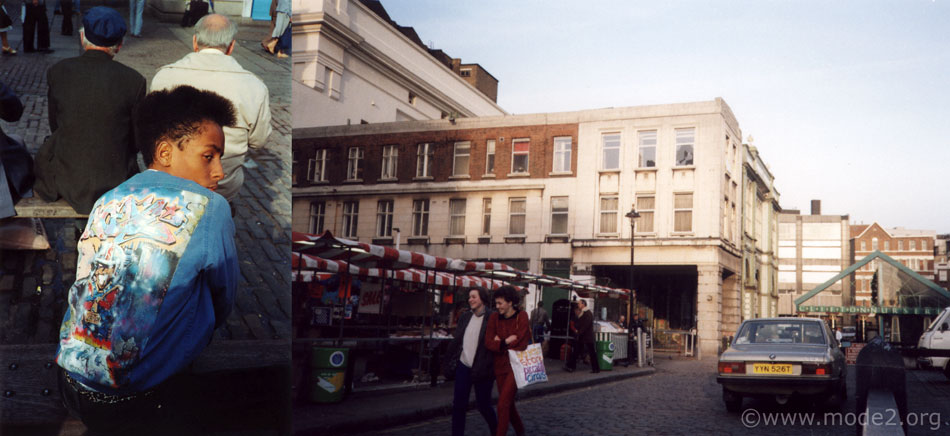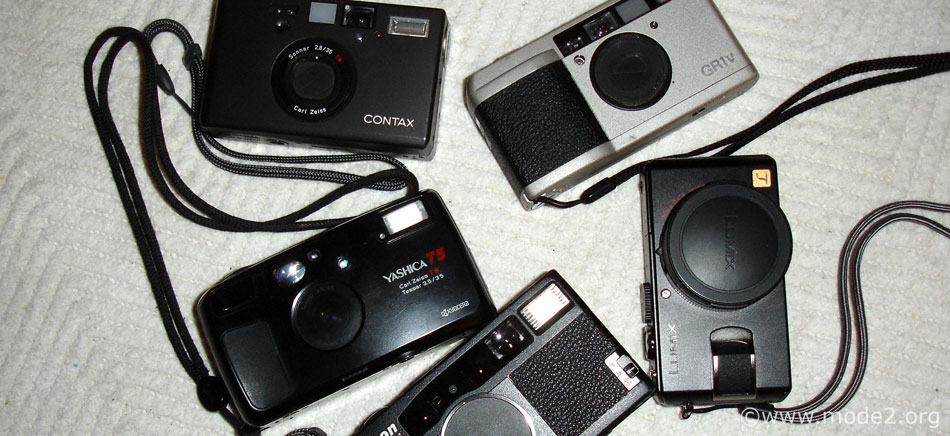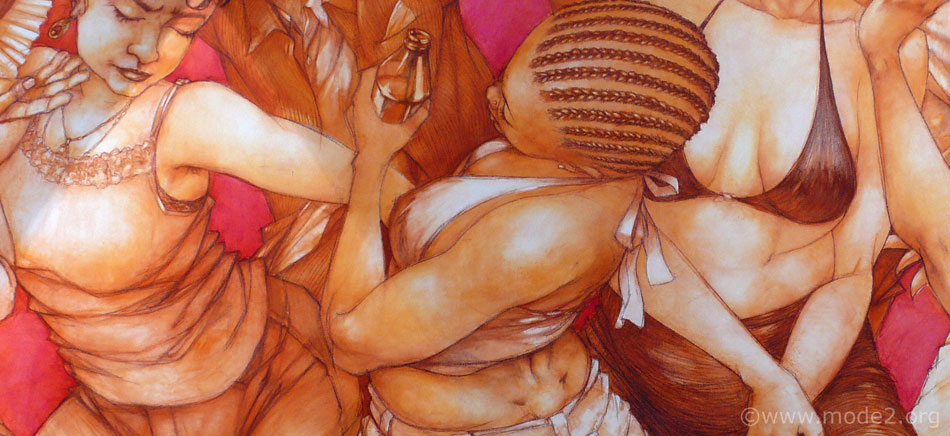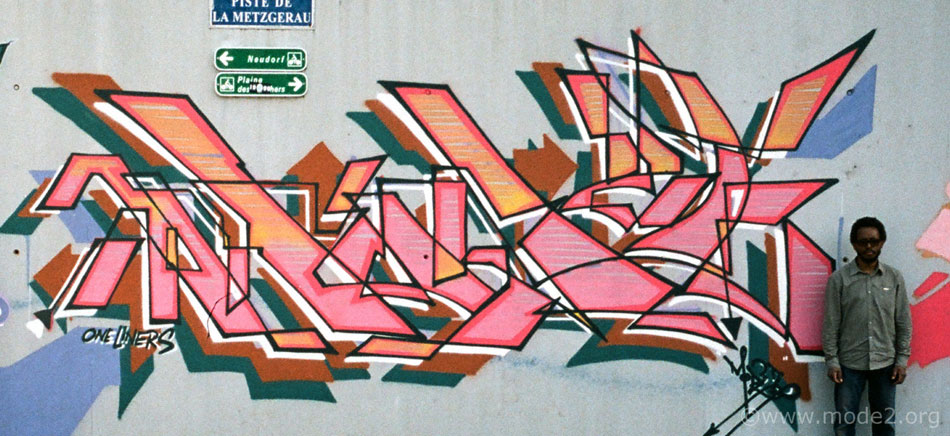I started this website in order to communicate directly with you, and dispel some of the myths you may have heard or read about me from other sources… Now take a deep breath, or get yourself a cup of tea or something; as the following biography is rather long.
I was born in Mauritius in 1967, spending my childhood under the sun of the Indian Ocean, before moving to the UK in July 1976. Punk had just started its own cultural revolution, while reggae and dub were ever present in the neighbourhood “blues” parties, as well as from the first real booming systems in the cars that would ever so often drive casually through the streets of Lewisham, South-East London. I did all of my schooling there, drawing since as far back as I can remember, spending my youth deep into comics, sci-fi and fantasy literature, as well as role-playing games such as “Dungeons & Dragons”.
I can’t forget to mention what effect the release of Star Wars, in 1977, had on my vision of the world around me. Before even getting into J.R.R. Tolkien, this movie was definitely a milestone in my childhood, and stoked a fire for science-fiction and fantasy which would have me look at the world around me in a totally different way from before.
All these influences, as well as the music coming from the radio, the TV and the street, were reflected in what I drew or painted; from comic strip characters to lead figurines, even to the odd oil portrait or landscape painting.
After my school exams in summer ‘84, I started hanging out in Covent Garden, the hub of the London Hip Hop scene, which I had discovered the year before, walking through it with my mother and the younger of my older brothers. My drawing ability led me to pick up the marker and spray-can, doing anything from painting banners for the “Alternative Arts” centre, or customizing the trousers or jackets of some of the other people hanging out with me, whether they were dancers or Mc’s. I was soon trying to make a name for myself, along with my partner Scribla, then with Zaki Dee, Eskimo, and Xerox as The Trailblazers, and eventually as part of a crew called The Chrome , which I formed in the spring of 1985, around the time of a seminal gig called The Rapattack, at the Shaw Theatre in the Euston area of London.

From summer ’84 on though, everything else came second to Hip Hop, and to that frantic rush to empty as many cans of paint as possible in the most beautiful way that I could, while filling up black-books full of letters and characters.
I would take days off of school just to travel to Paris, with money earned from my first commissioned jobs; and there, alongside the legendary Bando, I became part of that small group of first generation European graffiti-writers who set down the foundations that others would follow. We honed our talent for sure, but I must admit that we were also lucky to be in the right place at the right time; surrounded by a lot of inspiring stimuli, and even more inspiring people.
Then, in 1987, the cover of “Spraycan Art” exported my name and my characters to every corner of the planet where the culture had taken hold. I had told Henry that the New York writers were the ones deserved to be on the cover; but he explained that the publishers, Thames & Hudson, thought that the character I had done in Paris in September ’85 was the one that would best represent the content of the book to a wider audience, while underlining the global influence that the writing culture had acquired since 1984, and Henry and Martha Cooper’s previous book, Subway Art.
So that was the end of that, and the beginning of disproportional fame, which did not actually bring that much recognition to my work, but instead made some friends’ attitudes towards me change somewhat. Still, I used what I could from this new status and moved on.
Passionate about culture in general, I had started taking photos back in 1985, capturing the freshness, the vibe and the energy of the evolving Covent Garden scene around me, taken by the uniqueness of this phenomenon known as Hip Hop; where music, visual art, spoken word, percussion through the turntables, or corporal expression through dance all fed off of each other. This other passion has gone on ever since; burning rolls and rolls of 35mm film in compact cameras, trying out digital too, but not finding a digital compact camera which could do what light does to film emulsion. I spent loads of money on all of that, but haven’t made much use of my archives, aside from a few photos in the “Never Too Late…” book printed by the Lazarides Gallery in London, or else for one-off projections on certain events, beginning with one of the “Toxic” parties in Paris, back in early 2004.

More recently though, I got the chance to have twenty prints made of my archive shots, for a show at the Galerie Issue in Paris; showing how people used to socialize before the advent of digital cameras, internet, and the mobile phone.
The Hip Hop scene, no, not the rap crap, has always remained a source of inspiration for me; whether being on the edge of a circle with b-boys and b-girls going for theirs, or else having the luck to witness and hear a freestyle cipher in full flow; at Balboa Park for the B-Boy Summit in San Diego in early ’96, or earlier still outside the Def Jam Christmas party down on the waterfront district of NYC, in December ‘93. This is why I’m still doing the posters for the Battle Of The Year, for instance, while also sitting on its committee and remaining active for the promotion of dance as an art form in itself; not just an accessory to the video for some new dance track, or for some product advertising.
Speaking of dance, I must also add that meeting Swifty at the end of ’96, when his studio was part of the “Progress In Work” show at the Blue Note Club in Hoxton, was also another turning point in my life. It got me back into the London scene again, though from a different perspective than in my previous years in Hip Hop; making for instance flyer illustrations for the Monday nights at Bar Rumba, which led on to other collaborations with the likes of Ross Allen at Island Blue, and Jazztronik in Japan.
Though not at the forefront of the scene like before, while having to earn a living through commissioned work to support my family, and choosing to keep them away from curious eyes, I’m still present every now and again with the odd solo exhibition or group show, as well as doing painting performances on festivals such as Lovebox or Latitude, and even on the odd Hip Hop jam.
You may have noticed that I’m also generally obsessed by the female figure, which I’ve always enjoyed drawing, mostly from my own imagination, though also resorting to life drawing, or from my own photos, and even the odd sample from the internet once in a while. I try not to have a fixation on any given body type or shape; trying to draw more natural curves, while also trying to push for an indeterminate racial type which makes it easier for the female spectator to identify with…

While I may sometimes be expressing some rather harsh realities, or make use of some quite graphic and explicit imagery, I try somehow to breathe into it a hint of hope and positivity, trying to inspire and empower those who either discover my work for the first time, or else those who are already followers of my path since years. Through what I do, I try to communicate the kind of energy that could either help people to overcome some of the obstacles of daily life, or else to give them added vision in the search for answers to some of the questions that come up in life’s more long-term issues.
Still, when looking back over the years, what had helped me to really make my name was what many would call graffiti, though it was actually called “writing”, by those who practiced it and made it evolve.
Having taken note of the general disregard that the art media and intelligentsia have for this discipline, I am still striving to promote its importance in having democratized the access to expression with shape and colour, for many young people across the world. The tag, the lowest common denominator of writing, records the movement of he or she who executes it; revealing through its size and shape whether or not it was done from the wrist, the elbow or the shoulder; showing which can or marker had its perpetrator used, and betraying whether or not they had any sense of letter-dynamics, rhythm, and harmony. Ultimately, you can read how somebody dances through their arms or with letters, by looking at the size and shape and complexity of their tags or throw-ups…
More recently then, I have been come back to these roots of what some may call Hip-Hop, and the links which bind its different component disciplines together; the musical, visual and corporeal language that they have in common, sharing similar notions of style, form and rhythm which dissociates them from other cultural forms of expression.
Music, dance, and drawing or painting, have always been part of my life, and each of these disciplines have been there to support me when another was going through some trying times. This “reunion” is actually a logical step in my evolution; expressing the interdependency of these components which make up its whole.
There is for me a direct link between a particular sequence programmed into a drum-machine, a particular sequence of steps, twists and turns which make up a dance move; and the way in which we weave letter-shapes one into the other, in order to form a tag, a throw-up or a full-colour piece.
The notion of rhythm running through all three of these forms of expression is the same which binds them together within our culture; a vision of a world full of movement, of syncopation, off-beat and on-beat, of flow and of harmony; the sum of these elements being characterized by a driving force of positive energy, an empowering and healing force.
Yes, I’m known for my figurative contribution to spray-painting, and my characters may be what have helped to make me famous; but I’ll always stick to the shaping of letters as well, not forgetting that many other skilled hands and eyes are out there watching and judging what I choose to put out there.

As for the art intelligentsia and the cultural elites, those who attempt to pigeon-hole us, catalogue and categorize us; this all remains beyond them. However knowledgeable they may be about past and contemporary art forms, this is something that can only really be explained by those who practice it, and that means those who have practiced long enough or who are skilled enough to have a true understanding of its blueprint.
If you haven’t tried to do it for a certain amount of time, you just will not be able to fully grasp its principles; at least not to the level where you can have the pretension to make assumptions about it. Ours is a “hands on” culture by definition, and, up until today, this whole spectrum of shape and tone and rhythm still eludes definition by those from outside of it; not that we wish to be exclusive, as communication and the act of giving are an essential part of our form of expression.
I have always strived to build bridges between myself and those who are not from within the culture; finding the parallels that we have in common, and using those as bridges over which we can make an individual or an audience feel the energy that drives us. I have met restaurant and panini chefs, electricians and plumbers, who are more Hip Hop than certain individuals who either just dress the part, or have still not understood how deep this whole thing actually goes.
Those who control the established and accepted art media will still continue to talk about what they don’t understand, using vocabulary which does not fit the form and dynamics of what my predecessors as well as some of my contemporaries have given me the capacity to express myself with.
We, in the meantime, despite the plague of communication technology, will continue to evolve and refine what we do, choosing where and when we wish to reach out to the public, and give from what makes us feel alive.